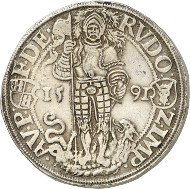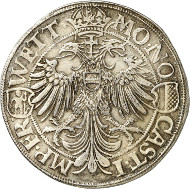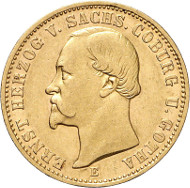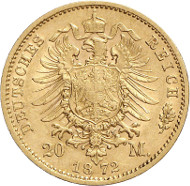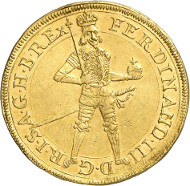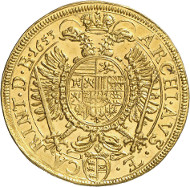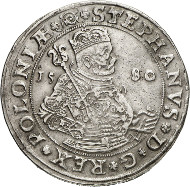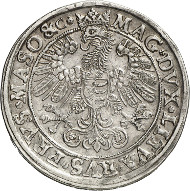04-10-2015 – 08-10-2015
Auction 234 Medieval and Modern Coins
Poland’s Modern Coins Top Seller
During the week from October 5th to 9th, 2015, coin collectors gathered in Munich. Presented in no less than three catalogs, a rich assemblage of numismatic items was to cross the auction block at Gorny & Mosch. The material covered all from high-quality ancient coins to modern art medals, from with ‘A’ as in Albania to ‘Z’ as in the German name of Cyrus, Zypern. Here we present you the results of the auction on medieval and modern coins. You can read an auction review on the sessions of ancient coins here.
Auction 234 – Medieval and Modern Coins
Before the auction even started it was obvious that many bidders would attend the sale to participate when the material from the pre-1871 Germany section crossed the auction block.
Accordingly good results were obtained. Let us begin with a small number of Augsburg thaler, in grades that marks every single piece a little bijou. Admittedly not rare and therefore estimated at only 5,800 euros, the total hammer price of all pieces, however, amounted to 11,000 euros, which was nearly two times the pre-sale estimates.
But this was only the beginning of the sale. The next two hours witnessed any number of noteworthy five-digit results. To mention only the most spectacular:
- Bavaria, 1777 gold medal (estimate: 25,000 euros / hammer price: 46,000 euros),
- Bretzenheim, 1790 ducat (estimate: 6,500 euros / hammer price: 13,000 euros),
- Corvey, 1652 thaler (estimate: 10,000 euros / hammer price: 14,000 euros),
Lot 4115: FRIEDBERG. Double thaler 1591. Unique. Extremely fine. Estimate: 40,000,- euros. Hammer price: 65,000,- euros.
- Friedberg, 1591 double thaler (estimate: 40,000 euros / hammer price: 65,000 euros),
- Magdeburg, 1673 double thaler (estimate: 30,000 euros / hammer price: 44,000 euros),
- Pomerania-Stettin, 1614 double thaler (estimate: 15,000 euros / hammer price: 20,000 euros),
- Regensburg, 1714 presentation piece of 10 ducats (estimate: 15,000 euros / hammer price: 23,000 euros),
- Saxony, 1830 prämienthaler (estimate: 20,000 euros / hammer price: 32,000 euros),
- Wuerttemberg-Oels, 1874 double thaler (estimate: 15,000 euros / hammer price: 22,000 euros).
Lot 4415: SAXE-COBURG-GOTHA. Ernest II, 1844-1893. 20 mark E 1677. Extremely rare. Nearly extremely fine / extremely fine. Estimate: 65,000,- euros. Hammer price: 85,000,- euros.
Anyone inclined to believe that the most expensive coin could be found in the pre-1871 Germany section, however, was proven wrong by the results of the sale. Realizing 85,000 euros, the rarest imperial gold coin type of all, the 1872 20 mark of Ernest II of Saxe-Coburg and Gotha, became the top-seller (estimate: 65,000 euros).
Looking at such prices, one could wonder if there are any inexpensive collecting fields left at all. As a matter of fact, there are. Modern art medals are grossly underestimated. Responsible for this is by no means a lack of artistic skill on the part of the medalists – rather, it is due to a minting industry going excessively wild in the 1970s that art medals continue to be ill-reputed among collectors. This makes the medals the only genre of Modern artistic creativity that is not affected by the current price increase for contemporary art. Let us take the series of medals created by the world-renowned, multiple award-winning medalist Kauko Räsänen (+ September 2015) which constituted a part of the material offered for sale at this Gorny & Mosch auction. The modest appraisals amounting to sums ranging between 50 and 1,000 euros, most specimens had pre-sale estimates somewhere between 100 and 200 euros. Most medals just realized their starting price, while a greater number of specimens were left unsold. If you are looking for a collecting area with a real potential, you might want to consider collecting contemporary art medals.
Lot 4609: HRE. Ferdinand III, 1637-1657. Double ducat 1653, St. Veit. Extremely rare. Extremely fine to FDC / FDC. Estimate: 5,000,- euros. Hammer price: 13,000,- euros.
The Holy Roman Empire, in contrast, does not suffer from a shortage of collectors, as evidenced by the results. Only a few results may suffice: a very rare Lienz cup-shaped denar from the County of Gorizia, for example, achieved 7,500 euros (estimate: 3,000 euros), an extremely rare 1653 double ducat, struck in St. Veit by Ferdinand III, obtained 13,000 euros (estimate: 5,000 euros), and a 1864 quadruple ducat, made in the Vienna Mint, realized 11,000 euros (estimate: 7,500 euros).
Lot 4854: POLAND. Stephen Bathory, 1576-1586. Thaler 1580, Olkusz. Extremely rare. Nearly extremely fine. Estimate: 50,000,- euros. Hammer price: 90,000,- euros.
Let us have a brief look at the foreign countries as well. In this department, Poland became the top-seller. Rising from its pre-sale estimate of 50,000 euros to no less than 90,000 euros, a 1580 thaler of Stephen Bathory, produced in the Olkusz Mint, was the most expensive item of the entire auction sale. A 1766 ducat of Stanislaw August Poniatowski, struck in the Warsaw Mint, on the other hand, far exceeded its appraisal of 7,500 euros when it was auctioned off for as much as 36,000 euros.
You can read an auction review of the auctions 232 and 233 on ancient coins here.
All results can be viewed on the internet in the results list.
The next auction of Ancient Art will be conducted on December 16th, 2015. The next coin auction is planned for March 7th-11th, 2016. Consignments are accepted until December 18th, 2015. Please contact Gorny & Mosch, Giessener Münzhandlung, Maximiliansplatz 20, D-80333 Munich, phone +49 / (0)89 / 24 22 643-0, telefax +49 / (0)89 / 22 85 513.
We present you an auction preview of the auction of Ancient Art here.




